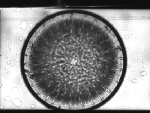 Welcome to
the diatom home page, intended as a central Web resource for those interested in, or
actively conducting research on, the diatoms and related algae. This page contains
information of general interest to diatomists and other phycologists along with links to
other useful Internet resources. Most of the information is downloaded from postings to
various LISTSERVers. Please contact P. Roger
Sweets with information or links you would like to share with the community.
I welcome all contributions.
Welcome to
the diatom home page, intended as a central Web resource for those interested in, or
actively conducting research on, the diatoms and related algae. This page contains
information of general interest to diatomists and other phycologists along with links to
other useful Internet resources. Most of the information is downloaded from postings to
various LISTSERVers. Please contact P. Roger
Sweets with information or links you would like to share with the community.
I welcome all contributions.
Last updated: June 23, 1998

The image above is a scanning electron micrograph (JPEG) of Cyclotella stelligera.
Diatoms are unicellular algae generally placed in the family Bacillariophyceae. The cell
walls of these organisms are made of silica, and the varied shapes and beautiful
ornamentation of these walls made the study of the diatoms and related siliceous organisms
a favored pursuit of the microscopical pioneers. The cell wall is also one of the major
reasons why these algae are today a favorite tool of modern ecological and evolutionary
researchers, because the fossils are often well preserved in lake and marine systems. And
that is, again, a small part of the story! Check the other Web sites below to learn
more!
However, sample these JPEG pictures to whet your appetite.
 This Mystery Diatom is growing mold,
let me know if you'd like to contribute the next one! To see a bunch of electron
micrographs (GIFs) of the now 3year old Mystery Diatom, go to the Mystery Diatom Page
This Mystery Diatom is growing mold,
let me know if you'd like to contribute the next one! To see a bunch of electron
micrographs (GIFs) of the now 3year old Mystery Diatom, go to the Mystery Diatom Page
Do not miss these!
Bowling Green State University Algal Images is a Web site with lots of great images. Check it out!
The Great Lakes Diatom Web Site from the University of Michigan. The future of diatom reference works.
The Diatom Collection of the California Academy of Sciences has sample locations, taxon collection, images, and a large diatom literature database on the WWW. A 'must' stop for diatomists.
The beginning of the fight for the hearts, minds, and codes of all diatomists - DIATCODE: A coded checklist of Diatom names (developed jointly by the ECRC and the Natural History Museum- UK). Downloadable.
Cyanosite
: bibliography, links, images of our favorite ex-algae the Cyanobacteria (Purdue University)Travel in cyberspace to Japan's Tsukuba University for images from many algal groups.
Excellent images and introductory material is offered by GEK, Inc. Hunt around for the video offerings of phagocytosis and other cool stuff as well.
Dr. R. Chapman's lab at LSU is now posting algal images on the Web.
If you're tired of the diatoms, check out Protist Image Data from the University of Montreal.
Buckman Laboratories has some downloadable photomicrographs of algae and other organisms.
The University of California Herbarium has a comprehensive catalogue of the Indian Ocean Benthic Algae.
Also, the all around great Berkeley museum site has a searchable catalog for
microfossil type specimens including diatoms and other protists (as well as some
images).
AND, a demonstration of the Index
Nominum Algarum and a list of Porphyra names (Richard
Moe)
Mike Guiry's Seaweed page has much, much mre: searchable databases of literature, people, and taxonomic names. A must link.
The Woods Hole Marine Biology group even has...Yikes! A Cladophora Web page!
Nothing like the Toxic Cyanobacteria Home Page to scare the kids...
Bengt Karlsson has announced the Checklist of phytoplankton from the Skagerrak-Kattegat (that's in the North Sea). Includes distribution info.
Chris Jeffries has recommended his Microscopes and Microscopy site to diatomists and phycologists browsing around.
Ed Drew's Research Shed is a fun link.
Cell biology and algal research at the Melkonian Laboratory, Botany Institute, University of Cologne
The Provasoli-Guillard National Center for Culture of Marine Phytoplankton offers information for those who feel the need to culture algae.
North East Pacific Culture Collection
Check out the Green Plant Phylogeny Research Coordination Group (GPPRCG) if you would like to coordinate with others chasing their phylogenetic dreams.
For other (non-diatom) museum holdings, see the many other great ecological home pages
listed on the paleolimnology page;
transfer to the California State BioWeb, perhaps
the best biological web server;
visit the Tree of Life;
or try the List of Internet
sites for Botanists.
A listing of announcements as posted to the LISTSERVs
15th NORTH AMERICAN DIATOM SYMPOSIUM, 22 to 25 September 1999 at the Pingree Park Campus of Colorado State University.
The DIATOM-L listserv is a forum for discussion of all matters
diatomaceous or microscopically siliceous. Subscribe at listserv@listserv.indiana.edu
Here is a list (with EMAIL addresses) of subscribers to
DIATOM-L.
View some common LISTSERV commands.
You can search an archive
of DIATOM-L.
The ALGAE-L listserv offers discussions of all things phycological.
Subscribe at LISTSERV@LISTSERV.HEA.IE or try Mike Guiry's algal WWW page.
The PSAlist is sponsored by the Phycological Society of America. Subscribe at listserv@yuma.acns.colostate.edu
There is also a general listserver for lakes: LAKES-L. Subscribe at MAJORDOMO@BADGER.STATE.WI.US
There is a Web page that describes the PHYCOTOXINS mailing list. Subscribe at Lists@scotia.dfo.ca
New stuff!
Jump back to the Paleolimnology Page

Last updated: June 23, 1998 URL: http://www.indiana.edu/~diatom/diatom.html Page design and comments: P. Roger Sweets Copyright 1995, The Trustees of Indiana University